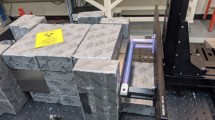Abstract
HTGR safety is secured by a system of barriers limiting the emission of fission products from the core into the surrounding environment during normal operation and postulated anticipated accidents. An experimental-computational analysis of two fundamentally important barriers — fuel kernels and their coating, whose function is to contain radionuclides and to protect workers and the environment, is examined. The function of the barriers and the requirements which they must satisfy are examined for HTGR fuel particles. The results of post-reactor studies are analyzed.
Mathematical models and computational codes simulating the behavior of fuel particles are analyzed. Probabilistic-statistical models and the GOLT code are being developed to evaluate the behavior of fuel particles under irradiation. Together with other models, this code is used for comparative test calculations of the behavior of particle fuel under normal irradiation conditions (<1300°C). The first results of such calculations are discussed.
Similar content being viewed by others
References
A. S. Chernikov, L. N. Permyakov, S. D. Kurbakov, et al., “Nuclear fuel for HTGR based on microspheres of plutonium oxide,” At. Énerg., 88, No. 1, 35–38 (2000).
R. B. Kotel'nikov, S. N. Bashlykov, A. I. Kashtanov, and T. S. Men'shikova, High Temperature Nuclear Fuel, Atomizdat, Moscow (1978).
Yu. G. Degal'tsev, N. N. Ponomarev-Stepnoi, and V. F. Kuznetsov, Behavior of High Temperature Nuclear Fuel under Irradiation, Énergoatomizdat, Moscow (1987).
A. Judd, Fast Breeder Reactors, Pergamon Press, New York (1981) [Russian translation, Énergoatomizdat, Moscow (1984)].
A. S. Chernikov, Z. A. Shokina, and V. I. Stolyarov, Radiation Behavior of Fuel Particles and Fuel Elements for HTGR Reactors, Review, TsNIIatominform, Moscow (1985).
R. Price, “Properties of silicon carbide for nuclear fuel particle coatings,” Nucl. Technol., 335, 320–336 (1977).
Y. Katoh, N. Nashimoto, S. Kondo, et al., “Microstructural development in cubic silicon carbide during irradiation at elevated temperatures,” J. Nucl. Mater., 351, 228–240 (2006).
J. Parados and I. Scott, “The influence of pyrolytic carbon creep on coated particle fuel performance,” Nucl. App., 3, 488–491 (1967).
J. Kaae, “A mathematical model for calculating stresses in a four-layer carbon-silicon-carbide coated fuel particle,” J. Nucl. Mater., 32, 322–329 (1969).
H. Walther, “On mathematical models for calculating the mechanical behavior of coated fuel particles,” Nucl. Eng. Design, 18, 11–39 (1972).
D. Martin, “A normally permissible method of simplifying, without any loss in accuracy, the Walther model for calculating the mechanical performance of coated fuel particles,” ibid., 30, 73–82 (1974).
K. Verfondern and H. Nabielek, PANAMA. Ein Rechenprogramm zur Vorhersage des Partikelbruchanteils von TRISO-Partikeln unter Storfallbedingungen. Jül-Spez-298 (1985).
W. Covacs, K. Bongartz, and D. Goodin, “High temperature gas cooled reactor fuel pressure vessel performance models,” Nucl. Technol, 68, 344 (1985).
R. Bennett, “Finite element stress analysis for coated particle fuel modeling under normal operating conditions,” ibid., 96, 117–122 (1991).
G. Miller and R. Bennett, “Analytical solution for stresses in TRISO-coated particles,” J. Nucl. Mater., 206, 35–49 (1993).
K. Sawa et al., “Development of coated particle failure model under high burnup irradiation,” J. Nucl. Sci. Technol., 33, No. 9, 712–720 (1996).
D. G. Martin, “Considerations pertaining to the achievement of high burn-ups in HTR fuel,” Nucl. Eng. Design, 213, 241–258 (2002).
M. Phelip, G. Degeneve, F. Michel, et al., “The ATLAS HTR and fuel simulation code objectives, description and first results,” in: Proceedings of Conference on High Temperature Reactors, Beijing, China, September 22–24, 2004, IAEA, Vienna, HTR-2004, pp. 1–10.
G. Miller, D. Petti, D. Varicalle, and J. Maki, “Statistical approach and benchmarking for modeling of multidimension behavior in TRISO-coated fuel particles,” J. Nucl. Mater., 317, 69–82 (2003).
N. N. Ponomarev-Stepnoi, T. A. Sazykina, and N. I. Tikhonov, “Methods for calculating the stress-strain state of HTGR fuel particles and choice of particle structure,” At. Énerg., 56, No. 2, 77–81 (1984).
V. S. Eremeev, E. A. Ivanova, V. N. Mikhailov, et al., “Mathematical model for describing stresses in fuel particles,” ibid., 58, No. 3, 189–190 (1985).
I. Golubev, I. Kadarmetov, and V. Makarov, “Mathematical model and computer code for coated particles performance at normal operating conditions,” in: Proceedings of Conference on High Temperature Reactors, Petten (NL), April 22–24, 2002, IAEA, Vienna, HTR-2002, pp. 1–16.
I. Golubev and I. Kadarmetov, “Current status of development of coated particle performance code GOLT,” in: Proceedings on High Temperature Reactors, Johannesburg, South Africa, October 1–4, 2006, p. B176.
M. Phelip, “European programme on HTR fuel technology,” in: Proceedings of the Second International Topical Meeting on High Temperature Reactor Technology HTR-2004, Beijing, China, September 22–24, 2004, IAEA, Vienna, HTR-2006, pp. 1–9.
M. Phelip, I. Golubev, D. Petti, et al., “The CRP-6 benchmarks on HTGR fuel behavior under normal operation,” in: Proceedings of the Nuclear Fuel and Structural Materials for the Next-Generation Nuclear Reactors, Reno, USA, June 6–8, 2006.
J. Maki, D. Petti, D. Hobbins, et al., NP-MHTGR Fuel Development Program Results, INEEL/EXT-1268 (2002).
P. A. Platonov, Ya. I. Shtrombakh, V. I. Karpukhin, et al., “Effect of radiation on graphite in high-temperature gas-cooled reactors,” Vopr. At. Nauk. Tekh., Ser. At.-Vodorod. Énerget. Tekhnol., No. 6, 77–81 (1984).
Author information
Authors and Affiliations
Additional information
__________
Translated from Atomnaya Énergiya, Vol. 105, No. 1, pp. 14–25, July, 2008.
Rights and permissions
About this article
Cite this article
Golubev, I.E., Kurbakov, S.D. & Chernikov, A.S. Experimental and computational study of the pyrocarbon and silicon carbide barriers of HTGR fuel particle. At Energy 105, 18–31 (2008). https://doi.org/10.1007/s10512-008-9061-6
Received:
Published:
Issue Date:
DOI: https://doi.org/10.1007/s10512-008-9061-6



